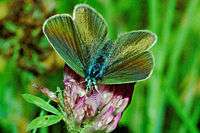Polyommatus semiargus
| Mazarine blue | |
|---|---|
.jpg) | |
| Male | |
| Scientific classification | |
| Kingdom: | Animalia |
| Phylum: | Arthropoda |
| Class: | Insecta |
| Order: | Lepidoptera |
| Family: | Lycaenidae |
| Genus: | Polyommatus |
| Species: | P. semiargus |
| Binomial name | |
| Polyommatus semiargus (Rottemburg, 1775) | |
| Synonyms | |
| |
Polyommatus semiargus, the Mazarine blue, is a butterfly in the family Lycaenidae. The wingspan of the male and female are similar,[1] at 32–38 mm.[2]


The Mazarine blue's population is distributed throughout continental Europe, even reaching into the Arctic Circle, Asia, the Middle East,[3] and Morocco.[4] There was a large native population in Britain in the early part of the 19th century, but it disappeared before the 20th century,[5][6] though single vagrants have been spotted,[7] and some estimates of British resident extinction are as late as 1906.[8] In 2009, UNESCO was researching a possible British reintroduction of the Mazarine blue to Britain.[9]
Recently, the Mazarine blue's numbers have been declining in its European range (particularly Scandinavia) and the reason remains unclear.
The butterfly feeds on red clover and other species of Trifolium. Its habitats are meadows, pastures, grasslands and flowery areas. It seems to prefer places which are not fertilized and not used for fodder production.
The male Mazarine blue's wings are a deep blue and are slightly larger in diameter than the female's. The female Mazarine blue is brown. Both sexes lack orange markings and have a dark violet or brown body colour. The butterfly has been compared to the common blue, and the Grecian Helena subspecies which has orange markings. Their flight time is from May to August.[10]
The larva is yellow green with darker lines and has fine hairs and dark brown spiracles. The pupa is olive green and attached to the food plant with a silk girdle.[11]
References
- ↑ "UK Butterflies - Mazarine Blue - Cyaniris semiargus". Retrieved 2010-07-03.
- ↑ "Cockayne Collection". Natural History Museum. Retrieved 2010-07-03.
- ↑ Recorded for example, in Syria: Graves, Philip P. (1905). "Notes on Egyptian and Syrian butterflies". The Entomologist's record and journal of variation. 19.
- ↑ "Specimens: Cyaniris semiargus". www.theinsectcollector.com. Retrieved 2010-07-03.
Locality: Morocco Sub Species: maroccana
- ↑ Eeles, Peter (2002). "UK Butterflies - Mazarine Blue - Cyaniris semiargus". www.ukbutterflies.co.uk. Retrieved 2010-07-03.
first mentioned as British in 1710 and there are several hundred sightings recorded up until the late 19th century. Various dates are given for the last sighting, although all are linked with a particular region. The end of the 19th century seems to mark a watershed, after which there are very few records.
- ↑ Dennis, Roger (1994). Butterflies and climate change. Manchester University Press. p. 134. ISBN 978-0-7190-4033-7. Retrieved 2010-07-03.
four species have become extinct [in Britain] (i.e. Lycaena dispar 1851, Cyaniris semiargus 1877, Aporia crataegi c. 1925, Maculinea arion 1979).
- ↑ Watson, L. (2008). "British Insects: Butterflies - Lycaenidae". delta-intkey.com. Retrieved 2010-07-03.
Cyaniris semiargus (Mazarine Blue - extinct, now occasionally adventive)
- ↑ "How many species have gone extinct in the last 100 years?". www.jncc.gov.uk. Retrieved 2010-07-03.
- ↑ "The UNESCO strategy for Action on climate change" (pdf). unesdoc.unesco.org. Retrieved 2010-07-03.
- ↑ "Mazarine Blue (Polyommatus semiargus) - Lycaenidae - Lepidoptera - Insecta - Wildaboutdenmark.com". www.fugleognatur.dk. Retrieved 2010-07-03.
- ↑ Stokoe, W.J. (1962). Observer's Book of Butterflies. Frederick Warne. p. 131.